The Great War
On the outbreak of the Great War, the regiment was stationed at the Curragh, Ireland. It embarked on the 15th of August 1914 at Dublin, under the Command of Lieutenant Colonel I.G Hogg DSO, and disembarked at Le Havre, France on the 18th of August. During the same evening, it entrained and the following day detained at Maubeuge, about 10 miles south of Mons. The regiment belonged to the 3rd Cavalry Brigade which comprised the 4th Hussars, the 5th and 16th Lancers, under the command of Brigadier-General H. de la P. Gough.
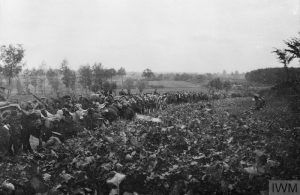 The brigade advanced in a North-Westerly direction towards the left of the British line, which was centred at Mons. During the afternoon of 22nd August, the regiment made its first contact with the Germans: some patrols had been sent out and these met a German patrol which promptly attacked. The Battle of the Mons raged all the next day during which the brigade was situated on the extreme left of the British line near Elouges. On a retirement being ordered on the 24th, our infantry in this area was pressed by the enemy and to relieve them, the whole of the Cavalry Division attacked the Germans, the regiment coming into action near Angre. The enemy was held up, the machine guns of the regiment doing considerable execution against their massed formations, which gave the guns an excellent target. At about 2.30 pm the regiment was ordered to retire, for the Retreat from Mons was about to begin.
The brigade advanced in a North-Westerly direction towards the left of the British line, which was centred at Mons. During the afternoon of 22nd August, the regiment made its first contact with the Germans: some patrols had been sent out and these met a German patrol which promptly attacked. The Battle of the Mons raged all the next day during which the brigade was situated on the extreme left of the British line near Elouges. On a retirement being ordered on the 24th, our infantry in this area was pressed by the enemy and to relieve them, the whole of the Cavalry Division attacked the Germans, the regiment coming into action near Angre. The enemy was held up, the machine guns of the regiment doing considerable execution against their massed formations, which gave the guns an excellent target. At about 2.30 pm the regiment was ordered to retire, for the Retreat from Mons was about to begin.
During the retreat, the Cavalry Division guarded the Western flank of the British line during which the regiment had many sharp scraps with the pursuing Germans. It was in one of these that Lieutenant Colonel Hogg DSO was mortally wounded on 1st September and died three days later. He was succeeded in command by Major Howell. The retreat was in a generally southerly direction and ended on the 5th of September when the British force had reached a point about 20-30 miles southeast of Paris and south of the River Marne.
The Germans however made a great mistake by going so far into France and leaving Paris untouched behind their right flank. A new French army was immediately formed to the northeast of Paris and threatened the German right flank from the rear. As soon as the German commander (General Von Kluck) was aware of this he stopped advancing and turned back to meet the danger now threatening him. But he moved his troops so quickly that he caused a large gap of 30 miles between his own troops and those of the German General next to him towards the east. The allies (i.e. the French and British) at once advanced against the Germans on the 6th of September, in which the regiment acted as advanced guard to the brigade. As our line advanced it continually made contact with the German rear guards and combats became numerous.
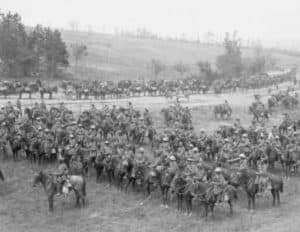 On the 10th of September at Gandelu, the regiment was fortunate in being present at a fight in which 1,000 Germans were captured. It also captured a German pay wagon together with a number of good maps. The whole German line was driven across the River Marne and fell back to the River Aisne where it entrenched itself. On several occasions, the cavalry tried to cross the bridge at Conde, but on each occasion, the Germans were able to bring a very effective concentrated fire in the attackers which compelled them to withdraw. In these operations, the regiment took its full share.
On the 10th of September at Gandelu, the regiment was fortunate in being present at a fight in which 1,000 Germans were captured. It also captured a German pay wagon together with a number of good maps. The whole German line was driven across the River Marne and fell back to the River Aisne where it entrenched itself. On several occasions, the cavalry tried to cross the bridge at Conde, but on each occasion, the Germans were able to bring a very effective concentrated fire in the attackers which compelled them to withdraw. In these operations, the regiment took its full share.
When conditions on the River Aisne came to a standstill both commanders of the opposing forces looked to their western flanks to see if they could get around their enemy. The Germans were bent on reaching the Channel ports and in order to counteract this move the British force was moved from its position on the Aisne in a northerly direction, finally coming to rest about Ypres. When in the Hollebeke area (south-east of Ypres) the regiment had to act very much on its own owing to the confused conditions which prevailed. The Germans’ attack did not reach the English Channel, but it gained a lot of ground, in the doing of which both sides had considerable casualties, the 4th Hussars losing many valuable officers and men.
Special mention must be made to Lieut. K.C. North was killed on 31st October 1914. Lieut North was in command of the regiment’s machine guns and carried out his duties fearlessly and excellently, without any regard for his personal safety. At Hollebeke he was isolated with his guns in front of the regiment and by his gallant conduct did great execution against the overwhelming numbers of Germans who approached his post. He had been recommended for the V.C and the D.S.O.
About the middle of November, the regiment suffered a good deal from “trench feet” owing to the wet and cold weather.
The great German attack is known as the First Battle of Ypres and owing to its failure, open warfare ceased for over three years, giving place to trench warfare. This latter type of warfare gave no scope for the regiment to act in a mounted capacity so it was employed, in common with other cavalry regiments, as a dismounted unit. On 2nd December the regiment was inspected by the King, this being the last memorable event of 1914.
1915
In February the regiment took over a part of the front lie in front of Ypres and here experienced for the first time the terrible conditions of warfare in trenches which had them knee-deep in mud. Although the conditions were very bad both officers and men soon settled down to overcome them in the usual British cheery manner.
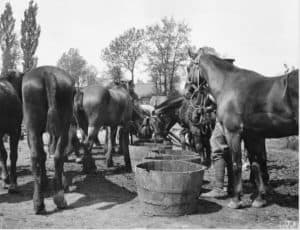 The Second Battle of Ypres commenced in April during which the regiment had its first experience of gas. It was occupying a position at Wieltje about a mile north-east of Ypres when just after 5 p.m, a greenish-yellow cloud 20 feet high and half-a-mile broad was seen bearing down upon it from St Julien, a mile to the north-east. There were no gas masks at this stage of the war and the only protection against gas was ordinary 4 ins by 2 ins flannelette, damped and held over the nose and mouth. The infantry came streaming back from a more advanced position suffering from the terrible effect of gas poisoning and many died as a consequence of it.
The Second Battle of Ypres commenced in April during which the regiment had its first experience of gas. It was occupying a position at Wieltje about a mile north-east of Ypres when just after 5 p.m, a greenish-yellow cloud 20 feet high and half-a-mile broad was seen bearing down upon it from St Julien, a mile to the north-east. There were no gas masks at this stage of the war and the only protection against gas was ordinary 4 ins by 2 ins flannelette, damped and held over the nose and mouth. The infantry came streaming back from a more advanced position suffering from the terrible effect of gas poisoning and many died as a consequence of it.
To replace the infantry at the front the 4th Hussars were ordered forward and led by the Commanding Officer (Major Rankin from the 7th Hussars), the regiment dashed forward through the heavy shell fire, then the gas cloud, past the retreating infantry into the area which had suffered from the effects of gas and occupied the empty trenches. The fine piece of work drew from the Brigadier-General Commanding the 3rd Cavalry Brigade a special report to higher authority in which he state “that the 4th Hussars gave a fine exhibition of nerve, coolness and discipline”.
During May the regiment held a position about Hooge, a mile east of Ypres, and later in the year moved south to take part in the Battle of Loos.
1916
In January a new battalion called the 3rd Dismounted Battalion was formed from three cavalry regiments, namely 4th Hussars, and 5th and 16th Lancers, each regiment providing one company. The company for the 4th Hussars consisted of 8 officers and 300 other ranks. The battalion went into trenches at Vermelles, just northwest of Loos. This was the first time the regiment experienced trench warfare on scientific lines, with a properly organised system of trenches, in place of the former hastily constructed scrapes in the ground. This organisation brought added dangers in that mining was carried on by both sides and the nearness to each other brought back into use various types of grenades and trench mortars, weapons that could do damage at a short distance.
Owing to the high proportion of head wounds inflicted by shrapnel, steel helmets were issued and the regiment received its first supply towards the end of January, these helmets were an undoubted success.
From the middle of February to the middle of June the regiment spent in billets at Vaudringherm, furnishing working parties to the 2nd Army. Lieutenant Colonel Rankin left the regiment in April after being promoted to command an infantry brigade. Under his able leadership, the 4th Hussars had done remarkably well. He was succeeded by Lieutenant Colonel Darley of the regiment.
Towards the end of the year, Major Mockett of the regiment started the 2nd Divisional Tactical School.
1917
The exceptionally bad weather conditions during the winter of 1916-17 seriously affected the condition of the horses and by the following spring, they were in a weak state and not fit for hard work. Nevertheless, when the Battle of Arras commenced on 9th April the regiment paraded mounted and ready to play its part. On this day heavy snow showers fell, which interfered with the operations and the British plan could not be fully carried out.
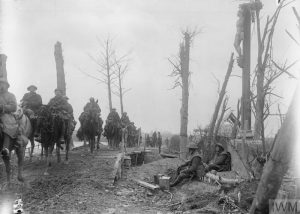 During the next few days the regiment moved from one part of the line to another, ready to take advantage of any opportunity should it occur, but snowstorms, accompanied by intense cold and strong winds prevented a continuance of the operation. The extreme weather conditions combined with short rations and exposure in open bivouacs seriously reduced the condition of the horses and a number died. The majority were only just capable of walking and the men were not much better.
During the next few days the regiment moved from one part of the line to another, ready to take advantage of any opportunity should it occur, but snowstorms, accompanied by intense cold and strong winds prevented a continuance of the operation. The extreme weather conditions combined with short rations and exposure in open bivouacs seriously reduced the condition of the horses and a number died. The majority were only just capable of walking and the men were not much better.
In May the regiment moved to the Canal du Nord sector, opposite the famous Hindenburg Line, and for the next two months had the usually varied experiences of a regiment holding a position of the front line, including some exceptionally fine patrolling work which earned them a special note from the Divisional Commander of the 2nd Cavalry Division, who wrote that “The work done by the 4th Hussars has been particularly good. The spirit of offence and the morale of the regiment generally have been very prominent and the example of the officers in much bold patrolling has altogether admirable.”
On the 20th of November, the Battle of Cambrai opened and a dismounted party from the regiment distinguished itself in the fighting about Bourlon Wood.
The year closed as it has begun, with snowstorms, which increased the unpleasant conditions of life for both man and horse.
1918
The year opened with the regiment doing tours in the front line and by the beginning of February began to prepare in common with all other regiments of the British force, to meet the much-advertised great German offensive, which was expected to commence any day. All officers were constantly busy reconnoitring the various routes to the front line and the system of trenches in the area.
During the winter some officers were away from the regiment attending the 2nd divisional Tactical School, now commanded by Major Laing, the 4th Hussars. Major Laing re-joined the regiment on the 21st of March when the German offensive started. For their last great effort to overthrow the Allies, the Germans concentrated overwhelming numbers against the British line and they fought very fiercely to attain their object.
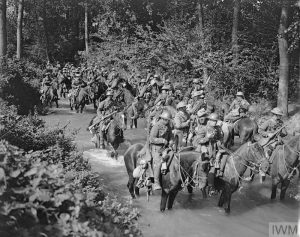 The regiment had a very varied experience which commenced on the 23rd of March when Captain (now Lieutenant Colonel) M.F Radclyffe was ordered to take a party and join a mixed force composed of parties from units in the 2nd Cavalry Division. Captain Radclyffe commanded the 3rd Cavalry Brigade squadron which for the next two days operated against the Germans to the north-east and west of Noyon, particularly at Bois des Essarts. The next day another party of the regiment carried on the fight at Bois des Essarts and did good work in holding up the Germans until forced to retire owing to greatly superior numbers being brought against them.
The regiment had a very varied experience which commenced on the 23rd of March when Captain (now Lieutenant Colonel) M.F Radclyffe was ordered to take a party and join a mixed force composed of parties from units in the 2nd Cavalry Division. Captain Radclyffe commanded the 3rd Cavalry Brigade squadron which for the next two days operated against the Germans to the north-east and west of Noyon, particularly at Bois des Essarts. The next day another party of the regiment carried on the fight at Bois des Essarts and did good work in holding up the Germans until forced to retire owing to greatly superior numbers being brought against them.
The whole British line withdrew during the next few days but on the 30th March, the regiment came into action again at Morevil, a few miles south-east of Amiens. The Germans were again held up here by the regiment’s excellent fire. Lieutenant Colonel Darley was killed here and he was succeeded by Major Laing in command.
After these exhaustive operations, the regiment was taken out of the line to recuperate, but during the first week of August, it was back again in Amiens ready for further serious work. Owing to the great secrecy which had been maintained, the British force under General Lord Rawlinson made a brilliant breakthrough of the German line east of Amiens on the 8th of August. The regiment followed closely behind the assaulting troops operating southeast of Amiens and just south of the River Somme, ready to take advantage of any opportunity for mounted action that occurred.
Unfortunately, the area had been fought over so much that it was covered with trenches and old wire entanglements which rendered mounted action impossible. Nevertheless, the regiment suffered many casualties from enemy shell fire and aerial bombing. On one occasion a bomb dropped on regimental headquarters and wounded five officers and on another, every horse in one troop was killed.
During the final advance of the Allies which overthrew the Germans the regiment was split up, ‘A’ Squadron cooperating with the 52nd (Lowland) Division, ‘B’ Squadron with the 12th Division and ‘C’ Squadron with the 8th Division, and thus the regiment took its full share in defeating the enemy after over four years of continuous warfare.
Two days after the Armistice (11th November 1918) all squadrons re-joined headquarters and the regiment marched to the Rhine on the 14th of November, going into billets until the end of the year.
In Remembrance
A nominal roll of the officers of the 4th Hussars who died, along with a summary of the war diary entry/event, during The Great War 1914-18 is now available.
You can view this document here.
Battle Honours
The 4th Queen’s Own Hussars were awarded a total of 21 battle honours during this period.
Why not find out the story behind each one:
- Mons
- Le Cateau
- Retreat from Mons
- Marne 1914
- Aisne 1914
- Messines 1914
- Armentieres 1914
- Ypres 1914’15
- Langemark 1914
- Gheluvelt
- St.Julian
- Bellewaarde
- Arras 1917
- Scarpe 1917
- Somme 1918
- Cambrai 1917
- Amiens
- Hindenburg Line
- Canal du Nord
- Pursuit to Mons
- France and Flanders 1914-18
The Great War 1914-18 Medals
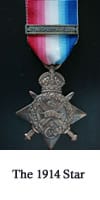
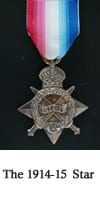
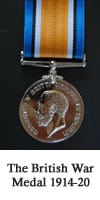
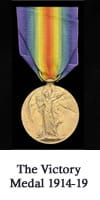
The 1914 Star was awarded to personnel who served in France and Belgium between 5 August and 22 November 1914.
The 1914-15 Star was awarded to personnel who saw service in any theatre of war between 5 August 1914 and 31 December 1915, other than those who had already qualified for the 1914 Star.
The British War Medal 1914-20 was awarded to personnel in recognition of the successful conclusion of World War 1. It was later extended until 1920 to cover mine-clearing services and operations in North and South Russia, the eastern Baltic, Siberia, the Black Sea and Caspian.
The Victory Medal 1914-19 was awarded to all personnel who received the 1914 or the 1914-15 Stars. It is often referred to as the Allied War Medal.

